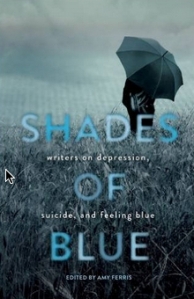 Shades of Blue is a book about depression, the blues, and suicide, yet it manages not to be depressing because of its humor, hope, and courage. This anthology of thirty-four personal stories, edited by Amy Ferris, concerns what’s locked up inside us. Ferris is open about her own struggles, her young girl attempt to kill herself, and how Robin Williams’ suicide prompted her to take on this project. “I live in a community where most folks don’t talk about suicide, or depression or feeling blue. It’s just not that kinda town. It’s gorgeous & quaint & oh, so beautiful. Filled with the most eclectic group of humans…. A couple of years ago we lost one of our favorite business owners—from a self-inflicted gun shot….”
Shades of Blue is a book about depression, the blues, and suicide, yet it manages not to be depressing because of its humor, hope, and courage. This anthology of thirty-four personal stories, edited by Amy Ferris, concerns what’s locked up inside us. Ferris is open about her own struggles, her young girl attempt to kill herself, and how Robin Williams’ suicide prompted her to take on this project. “I live in a community where most folks don’t talk about suicide, or depression or feeling blue. It’s just not that kinda town. It’s gorgeous & quaint & oh, so beautiful. Filled with the most eclectic group of humans…. A couple of years ago we lost one of our favorite business owners—from a self-inflicted gun shot….”
That kinda town isn’t unusual, highlighting how lonely depression can be—how dangerous that is—and how important it is people are beginning to go public about it. I’m a psychologist and some of my patients travel distances to see me, to keep their visits confidential. Shades of Blue: Writers on Depression, Suicide, and Feeling Blue is a courageous publication.
Because of my work, I’ve a singular interest in depression. I’m hyper-alert to suicidal thoughts, to signs of hopelessness and despair, to a person losing sight of the future. Yet, even with my experience, I remember reading William Styron’s memoir, Darkness Invisible, years ago and suddenly having a different understanding of that tunnel devoid of light. His book had a quiet presence—but it was Styron’s story. Shades of Blue isn’t one person’s story, and that’s why it’s significant.
The essays include accounts of personal experiences with depression, more than half which I’d describe as organic—depression that seems to be in a person’s bones, in the blood running through their veins—while others I’d consider more or less situational or reactive, as when the vicissitudes of life become overwhelming. There are also “witness” essays, in which the writer recounts the struggle of someone close, often a suicide. The impact on the person left behind is described as “a long memory—a complicated grief….” Another writer reflects on the shock of the unexpected; three friends laugh their way through college, and the one who was larger than life, who wore the tiara, becomes the revolving door patient of psychiatric hospitals until she can’t take it anymore.
Several authors are especially adept at engaging the reader in conversation. I could easily be sitting across the table from them, listening to their stories. Differing in their intensity, I sometimes needed to step away, especially if the narrator is still grieving; yet others are hopeful, and a number of essays offer unique voices and welcome humor.
The use of medications is discussed. Antidepressants may be a lifeline, particularly when depression starts early in life and becomes as much a part of the person as eye color. Others find alternative ways to cope—a protocol of meditation, right eating, yoga or alternative exercise, even skydiving—strategies more common when the unhappiness appears to be reactive or transitory.
Occasionally I get deep down depressed, although I’m not prone to the blues, and I remind myself it will pass, that I probably won’t feel like this a week from now. The contributors to this collection emerge offering a similar message learned through their personal experiences: Tomorrow will be better. Hang on; hang in.
When I was sixteen years old and seriously miserable, I swallowed six aspirin—and took several swipes across my right wrist with a razor blade (I was left-handed). Fortunately, I wasn’t seriously interested in dying. The teens and early twenties were the unhappiest times for me. I’m not alone. Adolescence is fraught with agony, especially for young people who are more vulnerable whether it’s because of brain chemistry or exogenous circumstances or a diabolical interaction of the two. Reference to unhappy childhoods is a common theme in this anthology. The “youngest” contributor is a woman still in college, who offers as much insight as anyone into her battle with the deep down blues and the solitude of the experience. Our culture continues to stigmatize mental illness, silencing the public acknowledgement of depression and its impact on those who suffer. Shades of Blue is insightful, compassionate, and heartening. It speaks to those who grapple with mental illness, those who love them, and those who want to better understand their experiences.
__
Nancy Jainchill is a practicing psychologist who, in pursuit of a long-delayed writing life, received an MFA from the Bennington College Writing Seminars Program in 2013. She has an essay included in the anthology Every Father’s Daughter, and her work has appeared The Dr. T.J. Eckleburg Review, Calyx, Free State Review, Entropy, and The Woodstock Times.
